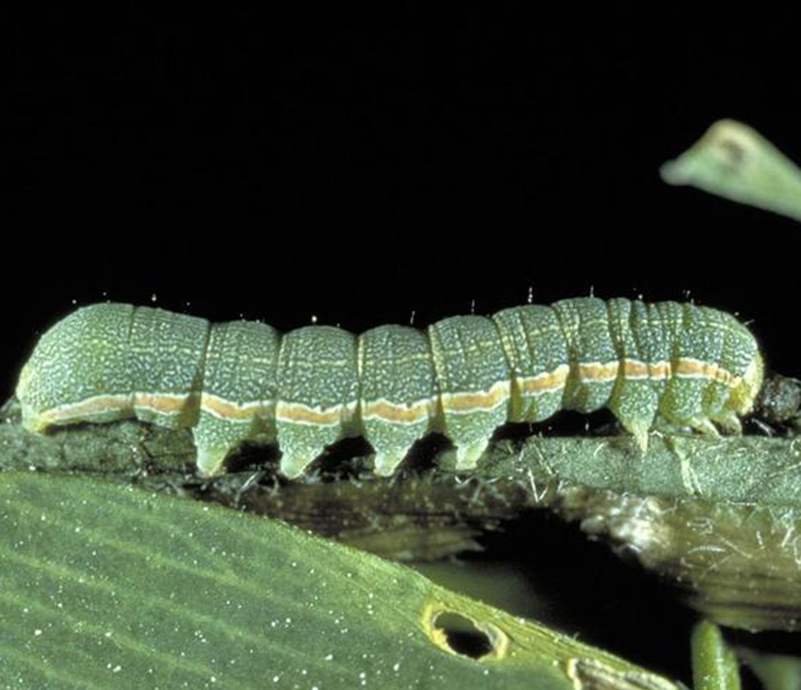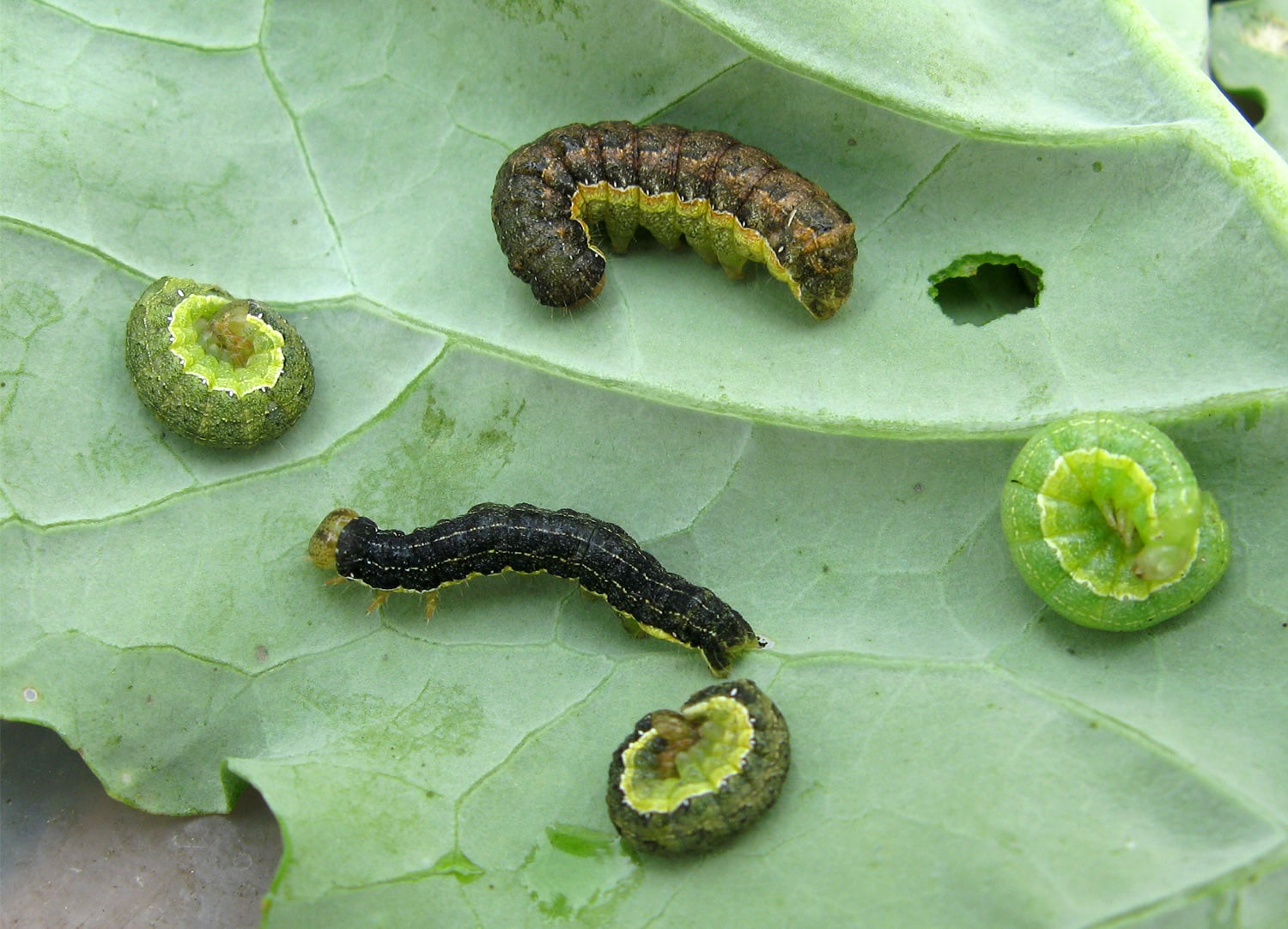Armyworms
Beet armyworm (Spodoptera exigua)
Bertha armyworm (Mamestra configurata)
Yellowstriped armyworm (Spodoptera ornithigalli)




Hosts
- Field-grown hemp
- Legumes
- Brassicas
- Leafy Greens
- Cucurbits
- Solanaceae Crops
- Root Crops
- Many herbaceous ornamentals
Appearance
Larvae are generally light green and marked with thin green-yellow stripes running the length of the body. Beet armyworms have a small black spot on each side of the second body segment behind the head. Yellowstriped armyworms vary in color from green to black. They have two yellow to orange stripes along the back, a dark spot on the sides of the fourth body segment behind the head, and black triangles along either side of the back. Bertha armyworms are green to black with a pale stripe on each side of the body. When disturbed, larvae of all species will curl into a c-shape. Adult moths are mottled gray and brown with light-colored markings on the wings and a wingspan of 25 to 45 mm. Eggs are small, pale white to yellow, ribbed, and usually found on the undersides of leaves in masses of 50 or more; eggs may be partially covered by hairs from the moth.
Damage Symptoms
Larvae feed on leaves with chewing mouthparts, causing skeletonized foliage (young larvae), irregular holes, shredded leaves, or defoliation (older larvae). Young larvae feed in groups while older larvae feed alone. Webbing (silk) may be associated with the damage. In hemp, larvae may move into maturing buds at high populations.
Life Cycle
Egg | Larva | Pupa | Adult
- 2-3 generations per growing season.
- Overwinter as pupae in the soil.
- Moths emerge from March to July, mate, and females lay eggs in clusters on host plants.
- Larvae feed for 5-8 weeks before pupating in the soil.
- Larvae of 2nd generation may be seen until early October before pupating in the soil to overwinter.
Time for Concern
Primarily July through September.
When and Where to Scout
- Scout plants biweekly from field planting to harvest for the presence of egg masses and/or larvae.
- Egg masses and groups of larvae are found on the undersides of leaves.
- Maturing larvae may be found singly towards the center of the plant or may be seen in the soil.
Threat Level
Low to medium.
Occurrence in Utah
Very few caterpillars have been found on field-grown hemp with little foliar damage.
Management
- Keep crop area weed-free.
- Till the field in after harvest to expose overwintering pupae.
- Scout plants biweekly throughout the growing season for egg masses and larvae.
- First (spring/early summer) generation larvae are likely to cause little damage; second generation larvae may damage leaves and spread to flower buds.
- Approved insecticides are available. One option is Bacillus thuringiensis (Bt), which must be consumed, so it should only be used when caterpillars are less than one-half inch in size.
When to Consider Treatment
Larvae of second generation have a greater capacity to cause significant damage to leaves and buds.
Look-alikes
Other larvae in the Noctuidae family.
Caterpillar Insecticides
| Utah-Registered Product | Active Ingredient(s) | Notes |
|---|---|---|
| Agree WG | Bacillus thuringiensis ssp. aizawa | |
| Aza-Direct Biological Insecticide | azadirachtin | |
| AzaGuard | azadirachtin | |
| AzaSol | azadirachtin | |
| Azatin O Biological Insecticide | azadirachtin | |
| Azatrol EC Insecticide | azadirachtin | |
| Azera Insecticide | azadirachtin | |
| BT Now | Bacillus thuringiensis ssp. kurstaki | Greenhouse use only. |
| Bug Buster-O Extinguish Ant Bait | pyrethrins | Greenhouse use only. |
| Deadzone | diatomaceous earth | |
| Deliver Biological Insecticide | Bacillus thuringiensis ssp. kurstaki | |
| DiPel DF Biological Insecticide | Bacillus thuringiensis ssp. kurstaki | |
| DiPel DF Biological Insecticide Dry Flowable |
Bacillus thuringiensis ssp. kurstaki | |
| DiPel PRO DF Biological Insecticide | Bacillus thuringiensis ssp. kurstaki | |
| Evergreen Crop Protection EC 60-6 | pyrethrins | |
| Ferti-Lome Dipel Dust Biological Insecticide (RTU) | Bacillus thuringiensis ssp. kurstaki | |
| Ferti-lome Fruit Tree Spray | pyrethrins | |
| Grandevo CG;WDG | Chromobacterium sub strain PRAA4-1 cells | |
| Javelin WG Biological Insecticide | Bacillus thuringiensis ssp. kurstaki | |
| Leprotec | Bacillus thuringiensis ssp. kurstaki | |
| Molt-X | azadirachtin | |
| Neemix 4.5 Insect Growth Regulator | azadirachtin | |
| Prizefighter | ammonium nonanoate | |
| Pycana | pyrethrins | Greenhouse use only. |
| Pyganic Crop Protection EC 1.4 II; 5.0 II | pyrethrins | |
| SPEAR-LEP | gs-omega/kappahxtx-hv1a | Supression only; combine with a Bt product for greater efficacy. |
| Tersus Insecticide | pyrethrins | |
| Thuricide N/G | Bacillus thuringiensis ssp. kurstaki | |
| Valent Professional Products DiPel Pro DF Biological Insecticide Dry Flowable |
Bacillus thuringiensis ssp. kurstaki | |
| Venerate CG | Burkholderia sp. strain A396 | |
| XenTari Biological Insecticide Dry Flowable | Bacillus thuringiensis ssp. aizawai |
Photo Credits
- Beet armyworm - John Capinera, University of Florida, Bugwood.org
- Bertha armyworm - Canola Council of Canada
- Yellowstriped armyworm - USU Extension IPM Program
- Eggs - Ronald Smith, Auburn University, Bugwood.org

